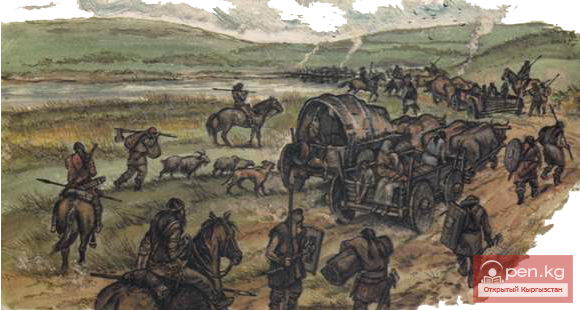The Presence of Numerous Clans and Tribes Among the Kyrgyz People
Life for a Kyrgyz outside the close ties with their circle of close and distant relatives was practically impossible. Every person sought to maintain these connections, strengthen them, and restore them if they were broken, with genealogical information playing an important role (Abramzon, 1960, p. 7), and kinship relations could be both real and fictitious.
The presence of numerous clans and tribes did not hinder the formation of a unified self-awareness among the Kyrgyz. On the contrary, the very minor differences in dialects and speech, the widespread presence of almost identical cultural elements, and behavioral stereotypes testify to the ethnic unity of the people. A vivid example of this is the existence of the heroic epic "Manas" among all Kyrgyz, which played a huge role in the consolidation of the ethnicity.
The clan-tribal structure of the Kyrgyz people is characterized by a complex hierarchy of subdivisions of different taxonomic levels (Aristov, 1896, Vol. 3-4; Abramzon, 1951; Asanov, 2011; Japparov, 2004).
The first and relatively detailed information about the clan-tribal structure, consisting of three large parts, dates back to the 16th century. This includes the right wing - on kanat, the left wing - sol kanat, and the internal clan-tribal group - içkilik.
The Kyrgyz living in the Xinjiang Uygur Autonomous Region of China attributed the entire group of otuz uul to the left wing and the entire group of içkilik to the right wing, while under the name "otuz uul," most Kyrgyz combined both wings (Abramzon, 1971, p. 26). The ethnonyms "bulgachy" and "on uul" referred to the group içkilik. Similar information can be found in the Persian-language work of the 16th century "Shajarāt al-Atrak," which contains a legend about the origin of the Kyrgyz and their division into two branches: Kyrgyz and otuz uul (Materials on the History of the Kyrgyz, p. 36). In the work "Majmuʿ al-Tawarikh" by Seyf ad-Din Akhsikenti, which chronologically belongs to the same century, events regarding the division of the Kyrgyz into on kanat and sol kanat are described. There is an opinion that "on" and "sol" serve as designations for the distribution of clan groups in relation to the cardinal directions (Sydykov, 1992, p. 85). The list of clans and tribes provided in "Majmuʿ al-Tawarikh" is almost entirely confirmed by data collected in the 19th-20th centuries, which allows us to speak of the stability of genealogical traditions (Joldoshov, 1999, p. 55). A.M. Khazanov noted that "the very principle of origin in nomadic societies manifests itself in two ways: in genealogies (genealogical descent) and in the ideas of the common origin of all members of this society... Both of these manifestations do not necessarily have to coincide with each other" (Khazanov, 2002, p. 245).
The right wing encompasses the branches shagai, adigine, and mungush. The first of these includes the tribes sary bagysh, bugu, sayak, solto, tyńymseyit, chekir sayak, zhediger, azyk, cherek, bagysh, monoldor, baaryn, suu murun. The adigine branch included the tribes: zhoru, beru, bargy, kara bagysh, sarttar. The third branch consisted of the subdivisions zhagalmai and kosh tamga, which in turn split into several tribes. The conglomerate of tribes within the right wing occupied the northeastern half of the territory of modern Kyrgyzstan, including most of the Kyrgyz of the People's Republic of China.
The left wing includes the tribes: kushchu (kushchu), saruu, munduz, zhetigen, kytay, basyz, tvbey, occupying the northwestern part of the territory of Kyrgyzstan, as well as chon bagysh. The clan-tribal group içkilik included the tribes kypchak, naymam, teyit, kesek, zhoo kesek, kandy, orgu, boston, noygut, tooles, avat, and sometimes the group kydyrsha was also distinguished (Abramzon, 1971, pp. 26, 27).
Manapstvo and Russian Reforms














































